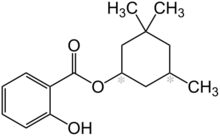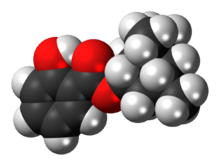Chemistry:Homosalate

| |

| |
| Names | |
|---|---|
| IUPAC name
3,3,5-Trimethylcyclohexyl 2-hydroxybenzoate
| |
| Other names
Homosalate
| |
| Identifiers | |
3D model (JSmol)
|
|
| ChemSpider | |
| KEGG | |
PubChem CID
|
|
| UNII | |
| |
| |
| Properties | |
| C16H22O3 | |
| Molar mass | 262.349 g·mol−1 |
| Density | 1.05 g/cm3 (20 °C)[2] |
| Melting point | < -20 °C[2] |
| Boiling point | 181–185 °C (358–365 °F; 454–458 K)[2] |
| 0.4 mg/L | |
| Hazards | |
| Flash point | 171 °C (340 °F; 444 K)[2] |
Except where otherwise noted, data are given for materials in their standard state (at 25 °C [77 °F], 100 kPa). | |
| Infobox references | |
Homosalate is an organic compound used in some sunscreens. It is made by the Fischer–Speier esterification of salicylic acid and 3,3,5-trimethylcyclohexanol, the latter being a hydrogenated derivative of isophorone. Contained in 45% of U.S. sunscreens, it is used as a chemical UV filter.[3] The salicylic acid portion of the molecule absorbs ultraviolet rays with a wavelength from 295 nm to 315 nm, protecting the skin from sun damage. The hydrophobic trimethyl cyclohexyl group provides greasiness that prevents it from dissolving in water.
Safety
This article needs more medical references for verification or relies too heavily on primary sources, specifically: relies too heavily on primary sources and in vitro experiments. (February 2014) |
Similar to other UV filter compounds,[4] more homosalate is absorbed into the uppermost stratum corneum (ie, the stratum disjunctum) of the face (25% of applied dose) versus back of volunteers. This amounted to approximately two to three times the amount of sunscreen that was present in the superficial stratum corneum layers of the face compared with the back. There was no homosalate detected in the urine samples or blood plasma samples of the volunteers in this study.[5][6]
Homosalate has been identified as an antiandrogen in vitro,[7] as well as having estrogenic activity toward estrogen receptors α,[8] and general in vitro estrogenic activity.[9] Homosalate has been shown to be an antagonist toward androgen and estrogen receptors in vitro.[10] Some work has shown that organic UV filters in general can present concerns.[11]
There is no in vivo evidence of toxicity, endocrine disfunction or adverse effects; and none of these adverse events have ever been reported to occur in humans.
An in vivo study involving repeated subcutaneous injections of homosalate at dose levels up to 1000mg/kg of body weight to juvenile female Wistar rats over three consecutive days revealed no estrogenic potential in the uterotrophic assay. Another study on immature Long-Evans rats receiving up to 892 mg/kg of body weight of homosalate in their daily diet found no estrogenic effects in vivo. Research on zebra fish also found no estrogenic effects after being continuously exposed to homosalate for 96 hours straight. The SCCS has declared there is no sufficient evidence that identifies pure homosalate as an endocrine disruptor in humans and further declared that in vivo research has confirmed that homosalate has no genotoxic, phototoxic or photosensitive effects when applied topically.[6]
References
- ↑ Homosalate, Merck Index, 11th Edition, 4660.
- ↑ 2.0 2.1 2.2 2.3 Record in the GESTIS Substance Database of the Institute for Occupational Safety and Health
- ↑ Homosalate, ChemIDplus.
- ↑ "Regional variation in percutaneous absorption in man: measurement by the stripping method". Arch. Dermatol. Res. 278 (6): 465–469. 1986. doi:10.1007/bf00455165. PMID 3789805.
- ↑ "Influence of anatomical site and topical formulation on skin penetration of sunscreens". Ther Clin Risk Manag 1 (3): 209–218. 2005. PMID 18360561.
- ↑ 6.0 6.1 "OPINION on Homosalate". Scientific Committee on Consumer Safety. June 2021. https://ec.europa.eu/health/sites/default/files/scientific_committees/consumer_safety/docs/sccs_o_244.pdf.
- ↑ Ma, R.; Cotton, B.; Lichtensteiger, W.; Schlumpf, M. (2003). "UV Filters with Antagonistic Action at Androgen Receptors in the MDA-kb2 Cell Transcriptional-Activation Assay". Toxicological Sciences 74 (1): 43–50. doi:10.1093/toxsci/kfg102. PMID 12730620.
- ↑ "Estrogenic activity of cosmetic components in reporter cell lines: parabens, UV screens, and musks". J Toxicol Environ Health A 68 (4): 239–251. 2005. doi:10.1080/15287390590895054. PMID 15799449.
- ↑ "Endocrine activity and developmental toxicity of cosmetic UV filters--an update". Toxicology 205 (1–2): 113–122. 2004. doi:10.1016/j.tox.2004.06.043. PMID 15458796.
- ↑ "Interaction of polycyclic musks and UV filters with the estrogen receptor (ER), androgen receptor (AR), and progesterone receptor (PR) in reporter gene bioassays". Toxicol. Sci. 83 (2): 264–272. February 2005. doi:10.1093/toxsci/kfi035. PMID 15537743.
- ↑ "Current problems in the use of organic UV filters to protect skin from excessive sun exposure". Acta Chimica Slovaca 6 (1): 82–88. 2013. doi:10.2478/acs-2013-0014. http://www.acs.chtf.stuba.sk/papers/acs_0149.pdf.
 |

